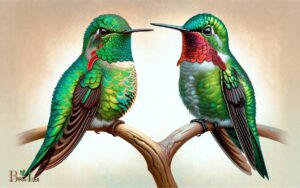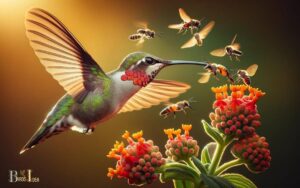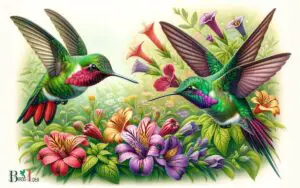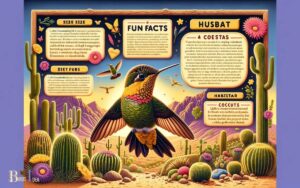10 Different Types of Hummingbird Moths: Features!
There are many different types of hummingbird moths, but 10 of the most common include:
Snowberry Clearwing Hummingbird Moth, Sphinx Hummingbird Moth, White-lined Sphinx Hummingbird Moth, Nessus Sphinx, Rustic Sphinx, Tersa Sphinx, Walnut Sphinx, Virginia Creeper Sphinx, Twin-spotted Sphinx, and Pandorus Sphinx.
There are several different species of hummingbird moths, including the snowberry clearwing, black-and-yellow hummingbird hawk-moth, apple clearwing, and hummingbird clearwing.
Here are some key features of hummingbird moths:
Hummingbird moths are an amazing species, as they look and act much like a hummingbird.
They are found all over the world, and they play a vital role in the pollination of flowers and other plants. They are a fascinating and beautiful species of insect.
10 Types of Hummingbird Moths
| S.No. | Type of Hummingbird Moth | Scientific Name |
| 1 | Clearwing Hummingbird Moth | Hemaris thysbe |
| 2 | Snowberry Clearwing Moth | Hemaris diffinis |
| 3 | Hummingbird Hawk-Moth | Macroglossum stellatarum |
| 4 | Broad-bordered Bee Hawk-Moth | Hemaris fuciformis |
| 5 | Slender Clearwing | Hemaris gracilis |
| 6 | Narrow-bordered Bee Hawk-Moth | Hemaris tityus |
| 7 | Sphinx Moth | Sphinx ligustri |
| 8 | White-lined Sphinx Moth | Hyles lineata |
| 9 | Oleander Hawk-Moth | Daphnis nerii |
| 10 | Elephant Hawk-Moth | Deilephila elpenor |
Key Takeaway
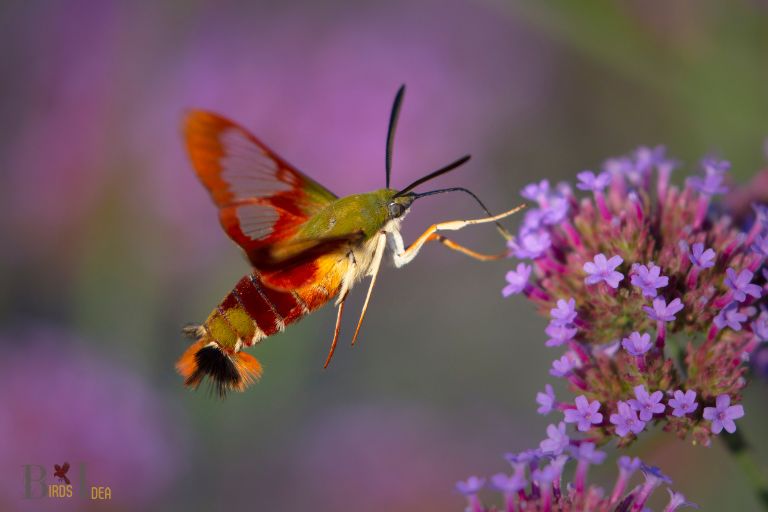
Five Facts About: Hummingbird Moths
10 Different Types of Hummingbird Moths
1. Hummingbird hawk-moth (Macroglossum stellatarum)

The Hummingbird Hawk-moth (Macroglossum stellatarum) is a species of moth in the Sphingidae family of hawkmoths. It is a day-flying moth that is found across much of Europe, Asia, and North Africa, as well as parts of North America.
This species is known for its rapid, hummingbird-like flight and long proboscis, which can reach up to 4cm in length.
They feed on nectar, primarily from flowers found in gardens, meadows, and woodlands. These moths live on average 2-3 weeks, although some may live up to a month or longer.
2. White-lined sphinx moth (Hyles lineata)

The white-lined sphinx moth (Hyles lineata) is a type of hummingbird moth, which is a group of hawk moths characterized by their hovering, nectar-drinking behavior that resembles that of hummingbirds.
It is typically found in open areas and gardens, where it commonly feeds on nectar-producing flowers.
The adult moth is easily identified by its colorful forewings, which sport a thin white line that runs along the length of the wingspan.
3. Clearwing sphinx moth (Hemaris thysbe)

The Clearwing Sphinx Moth (Hemaris thysbe) is a species of hummingbird moth. As the name suggests, the Clearwing Sphinx Moth resembles a hummingbird in both its appearance and feeding habits.
It is green and brown in colour with transparent wings, and it hovers around flowers, just like a hummingbird.
Its main difference from a hummingbird is its proboscis, which it uses to feed on nectar. The female Clearwing Sphinx Moth also lays eggs on the leaves of certain shrubs and trees.
4. Elephant hawk-moth (Deilephila elpenor)

The Elephant Hawk-moth (Deilephila elpenor) is a species of hummingbird moth found in temperate regions of Europe, North Africa and parts of Asia.
The moths have a distinctive elephant-like shape, with large proboscis and large, stripe-like wings. They feed on nectar from flowers and have a unique hovering flight pattern, similar to that of hummingbirds.
5. Hummingbird clearwing moth (Hemaris diffinis)

The Hummingbird clearwing moth (Hemaris diffinis) is a species of moth in the family Sphingidae. This species of moth has certain similarities to hummingbirds, such as their coloring and the way they hover while feeding on nectar.
They are found throughout North America and Europe, and come in a variety of colors and patterns.
The Hummingbird clearwing moth is a pioneer species, and its presence can indicate a healthy and diverse ecosystem.
The hummingbird moths are enchanting creatures that lend their beauty to the world
birdsidea
6. Privet hawk-moth (Sphinx ligustri)

The Privet Hawk-moth (Sphinx ligustri) is a species of hummingbird moth found across Europe and Asia. It is one of the larger species of hawk-moth, with grey-brown forewings that are patterned with pale lines and dark-streaks.
The hind wings are pinkish-orange and the body is mainly dark with white stripes on its abdomen. Its wingspan measures around 7-8 cm and its flight is unique, due to its hummingbird-like hovering abilities.
7. Silver-spotted skipper (Epargyreus clarus)

The Silver-spotted skipper (Epargyreus clarus) is a type of hummingbird moth that can be found in gardens and meadows across North America.
It is a medium-sized moth with a wingspan of around 2 centimeters and a metallic silver spot on its hindwing.
Its yellowish-brown body has a black border and two eye-shaped spots on each wing. This species is nocturnal and is active in the evening, when it can be seen nectaring on flowers and flying around garden lights.
8. Bedstraw hawk-moth (Hyles gallii)

The Bedstraw Hawk-moth (Hyles gallii) is a species of hummingbird moth belonging to the Sphingidae family. This moth has a wingspan up to about 3 inches and has a yellowish-whitish or pale brown body, with a white thorax and reddish-brown abdomen.
The Bedstraw Hawk-moth is found in Europe, temperate Asia and parts of North America. They visit flowers to feed and use the long, shiny proboscis to reach the nectar.
Mating aggregations can sometimes form in mid-summer evenings.
9. Tomato hornworm moth (Manduca quinquemaculata)

The tomato hornworm moth (Manduca quinquemaculata) is a species of large sphinx moth belonging to the family Sphingidae.
It is a type of hummingbird moth, as like other hummingbird moths, it hovers in mid-air while drinking nectar using its long proboscis.
It has a bright green and white striped body, with white saddle-shaped markings across its winged back, making it a beautiful and distinctive species.
10. Hummingbird moth (Hemaris sp.)

Hummingbird moths, also known as Hemaris sp., are small moths of the Sphingidae family. They are known for their unique appearance and ability to fly much like a hummingbird, which is how they got their name.
There are several subspecies of hummingbird moths, each with distinct features, such as striking eye-spots, long tails, and various color patterns.
These moths are found around the world in different climates, making them an interesting species to watch and study.
What Are Hummingbird Moths?

Hummingbird moths are a family of moths which, due to their size, shape, and hover-like flight patterns, resemble hummingbirds.
As true moths, they are primarily active at night and typically feed on nectar and pollen of flowering plants. They can help with the pollination of flowers, much like their namesake hummingbirds.
Physical Features of Hummingbird Moths

Hummingbird moths are small, beautiful, and unique invertebrates. They have a few distinct physical features that make them different from other moths and insects.
These features include:
- Wings – Hummingbird moths have specially adapted wings which allow them to hover and dart around in a similar fashion to hummingbirds, hence their name.
- Size – These moths are generally small and range between 1.5 to 2 inches in length.
- Color – The color of these moths is generally grey and white, and sometimes a faint yellow or pink.
The physical features of hummingbird moths allow them to thrive in different environments, and they are an important part of the ecology. While they are not commonly kept as pets
Where Do Hummingbird Moths Live?

Hummingbird moths are found all around the world, but primarily in milder climates. They primarily live in areas with plentiful sources of nectar, such as gardens and parks.
These small moths are typically found in:
- North America
- Europe
- South Asia
- The Mediterranean region
- Australia
The small moths prefer open and lightly wooded areas where their favorite nectar-producing plants grow. They are generally attracted to fragrant flowers, such as honeysuckle and petunias, and to plants in the mint family.
Hummingbird moths also frequent gardens and parks, where they can more easily find their nectar sources.
There are more than 1,200 species of hummingbird moths worldwide in the Sphingidae family.
birdsidea
What Do Hummingbird Moths Eat?

Hummingbird moths are small, diurnal moths, related to hawkmoths and sphinx moths. They feed on the nectar of various flowers, such as zinnias, petunias, impatiens, and lantanas.
They also feed upon the sap of many trees and shrubs, especially rhododendrons, mountain laurels, wooly bears and mock oranges.
Here are the list of what hummingbird moths eat:
- Nectar of various flowers such as zinnias, petunias, impatiens, and lantanas.
- The sap of trees and shrubs, particularly rhododendrons, mountain laurels, woolybears, and mock oranges.
- Extracts of honeysuckles, brambles and azaleas, along with a selection of other wildflowers.
- Low-growing flowers such as bluebells, poppies, clematis, and clover.
- Small amounts of plant sugars and amino acids.
- Fruit, such as apples, pears, and Plums.
- Pollen.
- Insects, such as flies, aphids, and mosquitoes.
- Sap from damaged or dying trees.
- Sap oozing from certain types of spider and caterpillar webs.
How Do Hummingbird Moths Reproduce?
Hummingbird moths reproduce by laying their eggs on vegetation or flowers and then mating. They typically breed from mid-spring through late summer, with mating pairs forming in the morning or late evenings.
After eggs are laid, they hatch within 7-14 days and go through several larval stages before pupating.
After emerging from the pupae, the adult moths live for about two weeks and are capable of reproducing shortly afterwards.

Benefits of Reproduction:
- Increase in the population size of hummingbird moths
- Allows the moths to spread to new environments and colonize more efficiently
- Can help the species survive environmental changes and pressures
- Enhances genetic diversity within the species and helps the population better adapt to changes in climate and food sources
- The resulting larvae and pupae can pollinate plants, helping to preserve local vegetation and ecology
- Mating rituals, physical traits and hunting behaviors are passed on and kept alive through successive generations
Reproduction is essential for the survival of any species and hummingbird moths have adapted their mating and reproduction habits to maximize their fitness and fitness of their offspring.
They are able to take advantage of the time of day, weather and geographical environment to ensure their population can thrive.
How Long Do Hummingbird Moths Live?

Hummingbird moths typically have an average lifespan of 2-3 weeks. Aside from normal predators that can shorten any insect’s lifespan, such as insects, birds, and spiders.
- Temperature: Warmer climates allow for more activity, increased consumption of nectar, and overall longer lives.
- Availability of food sources: Nectar is the primary food source for hummingbird moths, so the ability for them to find and access nectar is crucial for their life expectancy.
- Length of day: Longer summer days result in more time for hummingbird moths to be active, consume more food, and mate, leading to a longer life.
- Resources available: Hummingbird moths typically live in areas with lots of natural resources, such as flowers and trees, and their access to these resources contribute to their lifespan.
Are Hummingbird Moths Endangered?
No, hummingbird moths are not endangered. Hummingbird moths are widely distributed across Europe, Asia, and North America, making them quite common.
They typically inhabit gardens and other areas with plenty of nectar-producing flowers, making them a keystone species in pollination.

There are some threats to hummingbird moth populations, such as habitat loss and insecticides, but their numbers remain stable overall.
Other threats include exposure to harsh weather and predators such as spiders and birds.
Benefits of Hummingbird Moths:
- Pollination of flowers and plants
- Provide food to other animals, such as birds
- Can be found in most temperate regions
- Reasonably long lifespan
- Courageous, able to brave storms and cold weather
- Low reproduction rate and few natural predators
- Low-maintenance and easy to observe in gardens
- Good fliers and highly responsive
- Able to pollinate in pollination-poor areas
- Help restore damaged ecosystems
FAQ of 10 Different Types Of Hummingbird Moths
What are different types of Hummingbird Moths?
Where do Hummingbird Moths live?
How do Hummingbird Moths attract mates?
What kinds of food do Hummingbird Moths eat?
Conclusion:
Hummingbird moths are a fascinating and unique species of insects. They have a variety of physical characteristics that make them resemble both moths and hummingbirds.
There are several different species of hummingbird moths, each with characteristic size, color, and wingspan.
They play an important role in global pollination, helping flowers and plants to reproduce and grow.

